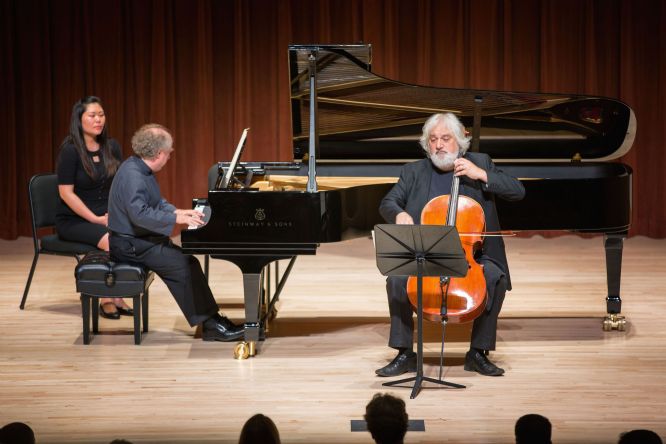|
Symphony
FROM THE NEW WORLD TO THE OLD WORLD
by Peter Lert
Saturday, June 14, 2025
Chamber
MC2 DUO RECITAL CLOSES 222'S SEASON
by Terry McNeill
Saturday, June 14, 2025
Choral and Vocal
CANTIAMO SONOMA'S LUSCIOUS A CAPELLA SINGING IN SEASON ENDING CONCERT
by Pamela Hicks Gailey
Sunday, June 8, 2025
Symphony
SRS SEASON ENDS WITH RESOUNDING TA-TA-TA-BANG
by Terry McNeill
Sunday, June 1, 2025
Symphony
YOUTHFUL VIRTUOSITY ON DISPLAY AT USO'S MAY CONCERTS
by Peter Lert
Saturday, May 17, 2025
Symphony
MYSTICAL PLANETS AND LIVELY GERSHWIN ORTIZ AT FINAL SRS CONCERT
by Peter Lert
Sunday, May 4, 2025
Symphony
VSO'S CONCERT MUSIC OF TIME, MUSIC OF PLACE
by Peter Lert
Sunday, April 27, 2025
VOCAL ELEGANCE AND FIRE AT THE 222'S RECITAL APRIL 26
by Pamela Hicks Gailey
Saturday, April 26, 2025
CANTIAMO SONOMA SINGS AN INSPIRED GOOD FRIDAY MOZART REQUIEM CONCERT
by Pamela Hicks Gailey
Friday, April 18, 2025
DRAMATIC SHOSTAKOVICH SYMPHONY CLOSES PHILHARMONIC'S 25TH SEASON
by Terry McNeill
Sunday, April 13, 2025
|
 |
 Pianist Jeffrey Kahane with Cellist Andrew Schulman June 26 in Schroeder Hall (N. Anderson Photo) |
BRAWNY BRAHMS HIGHLIGHTS OPENING CHAMBERFEST PROGRAM IN SCHROEDER
by Terry McNeill
Wednesday, June 24, 2015
Jeffrey Kahane has done it again. After multiple Sonoma County appearances since leaving the Santa Rosa Symphony in 2006, the pianist and conductor has designed a scintillating summer concert series at Sonoma Stateís Green Music Center Ė Chamberfest.
The first of nine concerts in a short five-day span June 24 featured a muscular program of Beethoven and Brahms, with a tiny Bach transcription as a tasty prelude. Beethovenís early Op. 5 F Major Cello Sonata received a sparkling reading with cellist Andrew Schulman joining Mr. Kahane, the charming introductory dotted rhythm leading into buoyant Allegro. Mr. Kahane pushed the tempo with his signature high-speed (and often muddy) right hand scales. Both the cello and piano lines were dynamically and fluently presented, sometimes declamatory with quick changes of mood, and the concluding Rondo was full of zest. It felt like something already in progress, a kick-up-your-heels gypsy dance. The composerís creativity with variation was everywhere underscored, and at several places the musicians slowed the tempo to a heartfelt simplicity and then sent the theme over the top in a wild gallop to the end.
It wasnít a subtle performance but it was thrilling, and the cellist deftly used a small vibrato and rich tone.
In his introductory remarks to the audience reviewing the Festivalís programs, Mr. Kahane commented that the most under-rated composer is early Beethoven, and this Sonata was a prime example.
Following intermission Brahmsí early and burly G Minor Quartet, Op. 25, was played by pianist Natasha Paremski, Margaret Batjer (violin), Mr. Shulman and violist Aloysia Friedmann. If a rough-hewn Brahms performance is desired, this one was sui generis. The sprawling opening Allegro was played to highlight a dark and brooding drama, the majestic and haunting theme returning several times before ending in a whisper.
This first of Brahmsís three piano quartets is perhaps the most popular, as the concluding Rondo is so similar to the admired Hungarian Dances. In the Intermezzo the unusual coloring and delicacy of the strings was beautifully set against each other and the piano line. A passionate love song characterized the Andante where Brahmsí glowing romanticism, later to be more tightly portrayed in the C Minor Quartet of Op. 60, was captivatingly performed. There were syncopated rhythms and a lovely ascending phrase ending the movement.
In the finale the quartet tore into the sectional, dance-like structure with terrific energy and especially in the cadenza where all the themes are combined in polyphony as accurate as Bachís and as fantastic as Lisztís. Schroeder Hallís sound favors big projection and Ms. Paremskiís sonority sporadically covered the strings, even with husky and fast scale passages from Ms. Batjer. The movement was played loud but never coarsely, and itís that kind of piece.
After a standing ovation all the musicians returned to the stage and took questions from the audience. Mr. Kahane is an old hand at these kinds of sessions, and in general his commentary is witty and urbane.
Gyorgy Kurtagís arrangement of Bachís O Lamm Gottes Unschuldig for piano, four hands, past by without much notice save for the organ-like timbre in the instrumentís treble. Mr. Kahane played octaves and fifths to emulate this unique sound, with elegant support by Ms. Paremski in the bass.
Nicki Bell and Sonia Tubridy contributed to this review.
|

